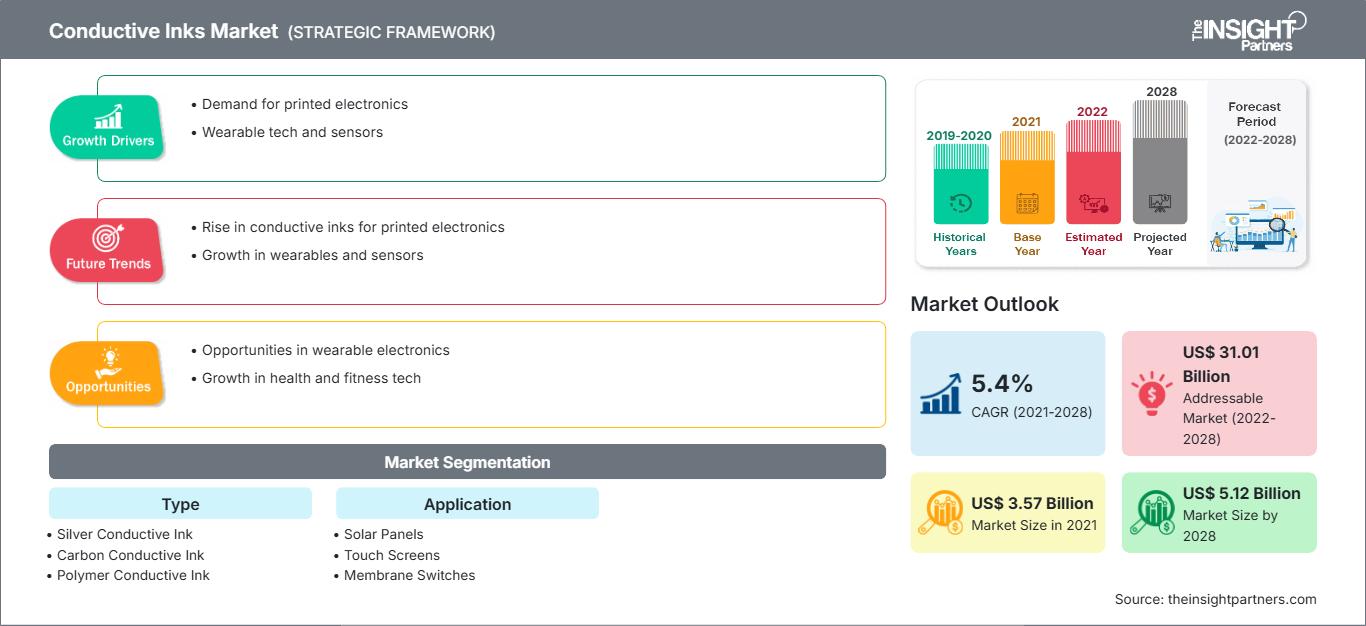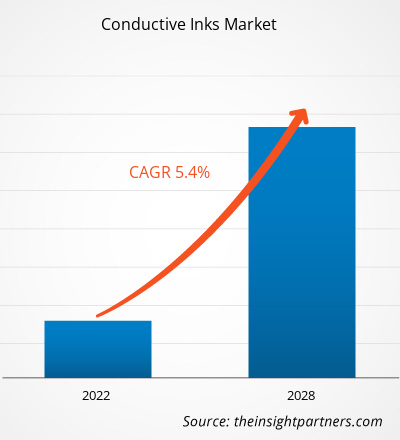[研究报告]导电油墨市场预计将从2021年的35.658亿美元增长到2028年的51.198亿美元;预计2022年至2028年的复合年增长率为5.4%。
世界各国政府都颁布了环保限制措施,鼓励各行各业用现代轻质材料取代设备中的重型材料。此外,消费者对微型和轻量电子产品的需求推动了消费电子行业对其产品的小型化。此外,快速增长的物联网应用和日益增长的小型化趋势预计将推动导电油墨市场的需求。智能手机和联网设备的快速增长推动了对更小、更轻、低功耗和高性能传感器的需求,从而刺激了对小型化的需求。中国在全球电子制造业的整个价值链中占据主导地位,并正在大力投资新技术,以快速生产小型化电子产品。因此,智能手机、可穿戴设备和其他电子设备对小型化的需求不断增长,以及对高效电子设备的需求不断增加,增强了导电油墨市场规模。
自定义此报告以满足您的要求
您将免费获得任何报告的定制,包括本报告的部分内容,或国家级分析、Excel 数据包,以及为初创企业和大学提供超值优惠和折扣
导电油墨市场: 战略洞察

-
获取本报告的主要市场趋势。这个免费样本将包括数据分析,从市场趋势到估计和预测。
新冠疫情对导电油墨市场的影响
受新冠疫情影响,许多柔性和印刷电子行业面临劳动力短缺。印刷电子应用对导电油墨的需求,例如现代公交票中使用的 RFID 标签印刷和汽车挡风玻璃除霜器,正在推动导电油墨市场的增长。此外,汽车行业产量下降也对市场产生了负面影响。根据国际汽车制造商组织 (OICA) 的数据,2019 年和 2020 年全球汽车销量分别为 91,227,182 辆和 78,774,320 辆。因此,由于导电油墨用于汽车电路和印刷除霜器(尤其是后窗),因此汽车销量下降对市场产生了负面影响。然而,从 2021 年中期开始,石油开采项目的恢复正在推动导电油墨市场的增长。然而,在疫情爆发之前,北美汽车行业的蓬勃发展、电动汽车普及率的提高以及人们健康意识的增强,推动了设备小型化的需求。消费电子行业也经历了增长。此外,对小型轻便电子产品(例如运动可穿戴手表)和用于监测健康的电子医疗设备的需求不断增长,也推动了导电油墨市场的增长。
市场洞察 - 导电油墨市场
太阳能电池板安装量的不断增长推动了导电油墨市场的增长
日益增长的能源需求使得利用替代能源成为必要。因此,可再生能源,尤其是太阳能,现在正被用于发电。预计未来几年太阳能发电的日益普及将推动对太阳能技术的需求,并增加太阳能电池板的部署。这将为光伏应用领域的导电油墨市场创造机会。导电油墨使用喷墨打印技术,可以在非常薄的柔性表面上印刷有机光伏太阳能电池板。为了与现有电网系统竞争,太阳能(光伏)行业一直面临着削减原材料成本和提高生产效率的巨大压力。在这种情况下,导电油墨是该行业的潜在解决方案,从而推动了导电油墨市场的发展。
基于类型的洞察
根据类型,导电油墨市场细分为银导电油墨、碳导电油墨、聚合物导电油墨、铜导电油墨等。碳导电油墨在2021年占据了最大的市场份额。碳导电油墨具有润滑性,摩擦系数低,热稳定性优异。这些油墨可用于丝网印刷、浸渍和注射器点胶,并且对玻璃和各种其他基材具有优异的附着力。与传统导电材料不同,碳油墨耐磨、耐刮擦、耐弯曲和耐折痕。印刷电子行业的快速发展促进了导电油墨的发展。碳基导电油墨的导电填料供应广泛、价格低廉、稳定性好,应用价值高。Nanoshel LLC、汉高和 Dycotec Materials Ltd 是碳基导电油墨市场的主要参与者。这些参与者的存在促进了市场的增长。
导电油墨市场的参与者主要致力于开发先进高效的产品。
- 2022 年,杜邦微电路和元件材料业务宣布推出 5881,这是一款用于医疗保健应用的新型银/氯化银导电油墨/浆料。
- 2021 年,杜邦宣布已成功完成对莱尔德性能材料公司的收购,莱尔德性能材料公司是高性能电磁屏蔽和热管理解决方案的全球领导者。
导电油墨市场区域洞察
The Insight Partners 的分析师已详尽阐述了预测期内影响导电油墨市场的区域趋势和因素。本节还讨论了北美、欧洲、亚太地区、中东和非洲以及南美和中美洲的导电油墨市场细分和地域分布。
导电油墨市场报告范围
| 报告属性 | 细节 |
|---|---|
| 市场规模 2021 | US$ 3.57 Billion |
| 市场规模 2028 | US$ 5.12 Billion |
| 全球复合年增长率 (2021 - 2028) | 5.4% |
| 历史数据 | 2019-2020 |
| 预测期 | 2022-2028 |
| 涵盖的领域 |
By 类型
|
| 覆盖地区和国家 |
北美
|
| 市场领导者和主要公司简介 |
|
导电油墨市场参与者密度:了解其对业务动态的影响
导电油墨市场正在快速增长,这得益于终端用户需求的不断增长,而这些需求的驱动因素包括消费者偏好的不断变化、技术进步以及对产品优势的认知度不断提高。随着需求的增长,企业正在扩展产品线,不断创新以满足消费者需求,并抓住新兴趋势,从而进一步推动市场增长。

- 获取 导电油墨市场 主要参与者概述
导电油墨市场根据类型和应用进行细分。根据类型,市场细分为银导电油墨、碳导电油墨、聚合物导电油墨、铜导电油墨等。2021 年,碳导电油墨细分市场占据市场主导地位,并占据最大的市场份额。在应用方面,市场细分为太阳能电池板、触摸屏、薄膜开关、医疗设备、印刷电路板、传感器、加热元件、射频识别、手机天线、汽车等。2021 年,印刷电路板细分市场占据市场主导地位,并占据最大的市场份额。从地理上讲,导电油墨市场大致细分为北美、欧洲、亚太地区 (APAC)、中东和非洲 (MEA) 和南美 (SAM)。2021 年,亚太地区占据了全球市场的很大份额。
Applied Ink Solutions;杜邦公司;汉高股份公司Inkron OY;Inktec;Heraeus;Novacentrix;POLY-INK;Merck KGAA;以及 Vorbeck Materials Corporation 是导电油墨市场的主要参与者。
- 历史分析(2 年)、基准年、预测(7 年)及复合年增长率
- PEST和SWOT分析
- 市场规模、价值/数量 - 全球、区域、国家
- 行业和竞争格局
- Excel 数据集
近期报告
客户评价
购买理由
- 明智的决策
- 了解市场动态
- 竞争分析
- 客户洞察
- 市场预测
- 风险规避
- 战略规划
- 投资论证
- 识别新兴市场
- 优化营销策略
- 提升运营效率
- 顺应监管趋势






















 获取免费样品 - 导电油墨市场
获取免费样品 - 导电油墨市场